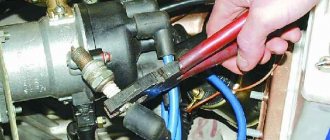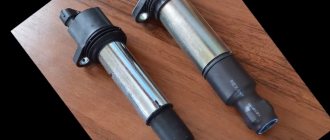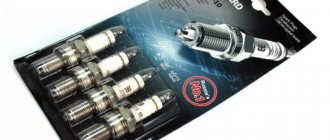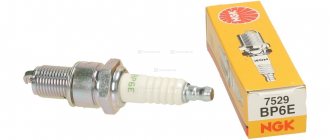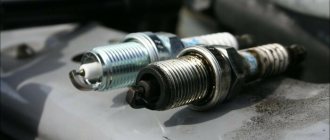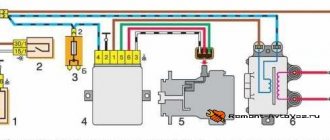Black carbon deposits on spark plugs, causes
Black carbon deposits on the electrodes and insulators are one of the most common spark plug problems.
Its appearance indicates certain problems in the operation of the car engine and its systems. In most cases, black soot is the remnants of an over-enriched fuel mixture that have not burned in the combustion chamber. Constant use of spark plugs with black soot leads to interruptions in their operation at best and complete failure at worst. This is reflected in engine operation by the appearance of dips and jerks, unstable idling (the engine “troits”), “shooting” at the muffler, loss of power and throttle response, and increased fuel consumption.
There are not so many reasons for the appearance of black carbon deposits on the spark plugs of a carburetor engine of a passenger car (for example, VAZ 2108, 2109, 21099, 2105, 2107). Below is a list of them in relation specifically to carburetor engines of VAZ 2108, 2109, 21099, 2105, 2107.
Reasons for the appearance of black carbon deposits on the spark plugs of a carburetor engine
— Reasons related to the carburetor and power system
Black carbon deposits on spark plugs are the result of a highly enriched fuel mixture, the residues from incomplete combustion of which are deposited on the electrodes and insulator of the spark plugs. This can lead to:
Increased fuel level in the carburetor float chamber (“overflow”)
The level is not adjusted correctly, the needle shut-off valve is not sealed, the float(s) are not sealed, the float(s) touches the walls of the float chamber, the fuel pump creates excess pressure (the drive pusher protrudes strongly).
Measuring the fuel level in the float chamber of the carburetor 2108, 21081, 21083 Solex
Measuring the protrusion of the VAZ fuel pump pusher
Wear or leakage of the power mode economizer ball valve
Excess fuel enters the engine not only in power modes, when the economizer should be turned on, but also in all other modes.
Economizer device for power modes of carburetor 2108, 21081, 21083 Solex
Clogged air jets of the main dosing systems
The fuel mixture becomes over-rich because not enough air is supplied to it.
Air jets, fuel jets, emulsion tubes and GDS wells of the Solex carburetor
The fuel mixture “quality” screw is not adjusted correctly
The adjustment was made in the direction of re-enrichment of the fuel mixture.
Screws for adjusting the “quality” and “quantity” of the fuel mixture of the Solex carburetor
The air filter is very dirty
In this case, the balance of fuel and air again shifts towards an excess of fuel.
Heavily contaminated car engine air filter element
— Reasons related to the ignition system
The ignition timing is not set correctly
Most likely the ignition is too early. The fuel mixture ignites too early and does not burn completely.
Ignition alignment mark on flywheel
The high-voltage wires, the cover or the “slider” of the distributor are “broken”
Current leakage through “broken” parts of the ignition system reduces the power of the spark or leads to its termination. The fuel mixture does not burn efficiently.
Ignition coil is faulty
The ignition coil may leak current through a crack in the cover. The consequences are similar to those described above.
The spark plugs themselves are faulty
The glow number of the spark plugs does not correspond to the engine, the gap between the spark plug electrodes is small, the spark plug is internally defective.
The listed malfunctions lead to interruptions in spark formation, a weak spark between the electrodes of the spark plugs and, accordingly, to poor and inefficient combustion of the fuel mixture. As a result, the engine “troubles” or does not start, the electrodes of the spark plugs are black.
— Reasons related to engine malfunction
Severe wear on piston rings
There is no compression in the cylinders on the compression stroke. Without the necessary pressure in the combustion chambers, the fuel mixture burns poorly and deposits black soot on the spark plugs.
Problems with the engine valve train
The valves are not sealed and their thermal clearances are not adjusted.
These reasons lead to inefficient combustion of the fuel mixture, its burning out in the intake manifold and, accordingly, the deposition of black deposits on the electrodes of the spark plugs.
Notes and additions
— If the engine and all its systems are operating normally, carbon deposits on the spark plugs are brown (the range of brown can be from light brown to dark brown).
Reasons for the formation of black soot
So why are spark plugs black? The accuracy of determining the causes of soot entirely depends on the analysis of its structure. The main forms of soot are dry (soot) and oily.
Experts believe that the main reason for the formation of black soot deposits is excessive enrichment of the fuel mixture. A motorist who is concerned about the condition of his car’s spark plugs simply needs to know the factors influencing increased enrichment of the fuel mixture:
- Malfunctions or incorrect carburetor settings.
- Due to a lack of oxygen flow due to a clogged air filter, complete combustion of the fuel mixture does not occur.
- Problems with the starting enrichment.
- The presence of increased pressure in the fuel rail (for injection power plants) contributes to excessive fuel injection. Occurs due to malfunctions of the fuel pressure regulator.
- Low compression value in one or more cylinders.
- Weak spark.
However, excessive enrichment of the air-fuel mixture is not the only answer to the question: “Why are spark plugs black?” There are several other reasons that influence (albeit to a lesser extent) the coating of spark plug electrodes with black soot. Here they are:
- Malfunction of the ignition coil.
- The air filter element is clogged.
- Increased (reduced) gap of the breaker-distributor.
- Capacitor failure.
- Incorrect operation of the injection system.
Possible reasons for the appearance of soot
Before answering the question of why the candles are black, you need to decide how exactly they turned black . After all, it depends on which direction to search. In particular, the candles can turn black all together, or maybe only one or two of the set. Also, the candle may turn black only on one side, or perhaps along its entire diameter. There are also so-called “wet” and “dry” carbon deposits.
It should be noted that the speed of appearance and nature of carbon deposits directly depends on existing faults (if any):
- Carbon deposits on new spark plugs begin to form after at least 200-300 km. Moreover, it is advisable to drive along the highway at approximately the same speed and engine load. This way the spark plugs will work in optimal mode, and it will be possible to more objectively assess the condition of the car’s components.
- The amount and type of soot depends on the quality of the fuel used. Therefore, try to refuel at trusted gas stations, and not drive with gasoline or similar mixtures. Otherwise, it will be difficult to establish the real cause of the appearance of soot (if it occurs).
- In a carburetor engine, the idle speed must be set correctly.
Now let's move directly to the question of why black soot appears on the spark plugs. There may be 11 main reasons :
- If you notice blackening on only one side, then most likely this is caused by a burnt-out valve. That is, carbon deposits on the spark plug fall on the side electrode from below (and not on the central one).
- The cause of black spark plugs may be a burnt-out valve. The situation is similar to the previous one. Carbon deposits may penetrate the bottom electrode.
- An incorrectly selected glow rating of a spark plug causes not only damage to it during further use, but also uneven blackening at first. If the mentioned number is small, then the shape of the soot cone will change. If it is large, then only the top of the cone will turn black, and the body will be white.
“Dry” carbon deposits on a candle
As a rule, when the ignition is set late and the air-fuel mixture is rich, the following consequences arise:
- misfires (error P0300 appears on injection engines);
- problems starting the engine;
- unstable engine operation, especially at idle, and as a result, increased vibration levels.
Next, we will tell you how to eliminate the listed faults and how to clean the spark plugs.
Causes of black soot
Before finding out the reason why the candles turned black, it is important to understand how this happened, how many of them turned black (one, two or all at once), on which side the soot formed (on one, two or all around), how “dry” it is. or "wet".
This determines how to diagnose and what to pay attention to first.
It is also important to understand that some malfunctions contribute to the rapid formation of black soot and affect its character, and some chronic engine problems can change the condition of the spark plugs gradually.
But before you indulge in various breakdowns, make sure:
- Is the idle speed set correctly, especially for carburetor engines?
- Are you driving the car correctly, are you not overloading the engine with high speeds, what is the cruising speed on a flat road. Those. It is important to make sure that the machine was operated as correctly as possible and the spark plugs worked in their optimal mode.
- If the conditions listed in paragraph 2 are met, the appearance of the first slight deposit on new spark plugs will occur after 150 - 200 km. If earlier, and it is clearly black, then you should sound the alarm.
- Where do you refuel and what kind of fuel do you put in the tank? If you often drive on gasoline, then don’t be surprised by black spark plugs, but you won’t be able to really find out why they became that way. Also, in the cylinder, at a temperature of about 500 0 C, low-quality gasoline does not burn completely, which also causes black soot on the spark plugs.
What to do if soot appears
First of all, it is necessary to remember that oil contamination and overheating, which results in soot on the spark plugs, are very harmful to the ignition system . Overheating is especially dangerous, since it causes the possibility of failure of the electrodes on the spark plugs without the possibility of their restoration.
If your car only has one blackened spark plug, you can diagnose the breakdown by simply swapping the spark plugs. If after this the new spark plug also turns black and the old one clears up, it means that the problem is not in the spark plugs, but in the cylinder. And if nothing has changed, then questions arise about the performance of the candle itself.
Oil deposits
In some cases, the candles may be wet and black. Most often, the reason for this fact is oil getting into the combustion chamber. Additional symptoms of this problem are as follows:
- difficulty starting the engine;
- omissions in the operation of the corresponding cylinder;
- the engine jerks during operation;
- the appearance of blue smoke from the exhaust.
Oil can enter the combustion chamber in two ways - from below or from above. In the first case, it enters through the piston rings. And this is a very bad sign, because it often threatens a major engine overhaul . In rare cases, you can get by with decoking the engine. If oil enters the combustion chamber through the top, it comes from the cylinder head along the valve guides. The reason for this is the wear of the valve stem seals. To eliminate this problem, you just need to select new, high-quality caps and replace them.
Carbon deposits on the insulator
Red carbon deposits on a candle
In some cases, carbon deposits that naturally appear in the combustion chamber can come off the piston at high engine speeds and stick to the spark plug insulator. The consequence of this will be gaps in the operation of the corresponding cylinder. The engine will “trouble” in this case. This is the most harmless situation why spark plugs turn black. You can eliminate it simply by cleaning their surface or replacing it with new ones.
If black and red spark plugs , this means that you are pouring fuel with an excessive amount of metal additives. It cannot be used for a long time because over time, metal deposits form a conductive coating on the surface of the spark plug insulator. Sparking will deteriorate and the spark plug will soon fail.
Cleaning spark plugs
Black plaque - what is it?
It is black carbon deposits that most often form on spark plugs. There are 2 types of black soot - the structure of the plaque also varies. If the coating has a grayish tint, there is no need to worry - this is a sign of stable engine operation.
If the electrode or threaded connections are covered with oily soot, this means that when the engine is running, too much working fluid ends up in the combustion chamber. This phenomenon has an accompanying symptom: when the engine starts, blue smoke begins to come out of the exhaust. There are several possible reasons:
- piston caps are worn out;
- the piston rings have become unusable;
- valve bushings have expired.
The appearance of black carbon deposits on spark plugs is associated with wear and tear on the components of the cylinder-piston system. The problem is solved by replacing worn parts with new ones.
Another type of resin deposit is called “velvety.” In this case there are no traces of oil. The appearance of soot deposits of this type is associated with the appearance in the combustion chamber of a TV mixture, the fuel content of which greatly exceeds the norm. Then a dry resin deposit forms. This occurs due to a malfunction of the candle - if it has ceased to produce the amount of energy necessary for ignition. Soot settles on the electrodes and never appears on the threads.
Cleaning spark plugs from deposits
Cleaning candles must be done regularly, as well as inspecting their condition. It is recommended to do this after approximately 8.10 thousand kilometers . It is very convenient to do this when changing the engine oil. However, if the symptoms described above occur, you can do this earlier.
it is not recommended to use the old method of using sandpaper to clean electrodes . The fact is that this creates a risk of damaging the protective layer on them. This is especially true for iridium spark plugs . Their central electrode is thin and coated with iridium, which is a semi-precious and rare metal.
To clean spark plugs you will need:
- detergent to remove plaque and rust;
- disposable plastic cups (after completion of the cleaning procedure they must be disposed of; they cannot be used for food products in the future);
- a thin brush with hard bristles or a toothbrush;
- rags.
The cleaning procedure is performed according to the following algorithm:
- The cleaning agent is poured into a glass prepared in advance to a level that completely immerses the spark plug electrodes (without an insulator).
- Immerse the candles in the glass and leave for 30-40 minutes (during the process, a chemical cleaning reaction occurs, which can be observed with the naked eye).
- After the specified time has elapsed, the candles are taken out of the glass, and using a brush or toothbrush, plaque is removed from the surface of the candle, especially paying attention to the electrodes.
- Wash the candles in warm running water, removing the chemical composition and dirt from their surface.
- After washing, wipe the candles dry with a rag prepared in advance.
- The final stage is to dry the candles on a radiator, in the oven (at a low temperature of +60...+70°C) or using a hairdryer or fan heater (the main thing is that the remaining water in them completely evaporates).
The procedure must be carried out carefully, cleaning and removing all dirt and plaque present on the surface. Remember that washed and cleaned candles are 10.15% more effective than dirty ones .
Results
The appearance of a black spark plug on a carburetor or injector can be caused by various reasons. As a rule, there are several of them at once . For example, incorrectly selected spark plugs, prolonged engine operation at high speeds, incorrectly set ignition, faulty valve stem seals, and so on. Therefore, we recommend that if the symptoms described above appear, you simply periodically check the condition of the spark plugs on your car.
This way you will not only extend the life of the engine, but also maintain power and driving comfort. You can see additional information on how you can diagnose a car engine by the color of spark plug soot.
Removing black deposits from spark plugs
Regularly checking the condition of the spark plugs will allow the car owner to not only accurately diagnose the degree of performance of the main vehicle systems, but also promptly eliminate the causes of problems, thereby minimizing the possibility of negative consequences. A symptom that encourages the car owner to inspect the spark plugs may be difficult starting of the power unit, since carbon deposits significantly reduce the resistance of the spark plug insulator. However, it is necessary to follow a certain, absolutely simple technique.
As is known, modern spark plugs have the property of self-cleaning from deposits (carbon deposits) when operating at high temperatures created by a car engine operating at high speeds. That is why, to get a reliable picture of the condition of the spark plugs, drive your car 20-30 kilometers at high speed before checking.
Now a few words about removing carbon deposits from the electrodes of car spark plugs. There are two main cleaning methods: chemical and mechanical.
Black carbon deposits on spark plugs on a carburetor engine - causes
When black carbon deposits are detected on spark plugs, every car owner must understand and find out the cause of the occurrence and what malfunctions appeared in the car. And the most common malfunction can be considered the use of low-quality fuel for a long time, a malfunction in the ignition system, an incorrectly adjusted carburetor internal combustion engine and a mismatch of the hot-air system. Diagnosing these problems is very easy; just look at the blackened spark plugs.
What could be the reasons for the appearance of dark soot on candles?
First, you need to determine what caused the blackening of the candles.
After all, this may directly depend on which direction the car owner moves in order to subsequently discover the exact cause. They can turn black either all at once or individually. When clarifying, it is worth considering how quickly this happens and the immediate nature of this phenomenon. On completely new spark plugs, carbon deposits begin to appear as if only a little after two hundred to three hundred kilometers of the vehicle. In this case, it is best to travel along the highway with the same speed limit, so it will be much easier to detect malfunctions.
The amount and type of carbon deposits formed directly depends on the quality of the fuel poured into the gas tank. There is no need to experiment and refuel your car at different gas stations each time. As a result, it simply will not be possible to correctly assess and accurately detect the obvious cause of the appearance of soot.
There are several main reasons why soot forms on them:
- If in the end blackening is noticed only on the 1st side, then this is more than likely caused by a burnt-out valve. In this case, carbon deposits on the spark plugs fall from below onto the side electrode and not onto the central electrode.
- In a situation where incorrectly selected spark plugs can cause not only damage during operation, but also uneven darkening.
The heat number is a value that characterizes the time it takes for it to reach ignition. If a large potassium number is indicated on it, then it will heat up less. When uniform carbon deposits appear on the spark plugs, it indicates that delayed ignition is occurring.
The appearance of black spark plugs on a carburetor engine can be caused by the following factors: the fuel level was not adjusted correctly, the needle shut-off valve is depressurized, the fuel pump creates excessive pressure, the float is depressurized.
Why do oil and gasoline stains appear on spark plugs?
In addition to differences in the color shades of deposits, a number of other factors can indicate problems with the engine:
- The appearance of erosion on the electrodes. This reason is associated with the combustion of a low-quality fuel mixture in the engine chamber. In addition, erosion occurs when the fuel contains high levels of lead.
- The appearance of black ash between the electrode gaps. Ash may appear if the oil in the engine cylinders does not burn completely. As a rule, the problem is related to the serviceability of the rings on the piston system. Thus, deposits in the form of ash act as an insulator, which blocks the achievement of the required voltage for a spark to appear and pierce the resulting insulating layers.
- The appearance of a small amount of oil on the surface. Deposits in the form of drops of used oil occur only when cracks appear in the valves or when the gap in the partitions between the piston rings increases. Sometimes a mechanic in a car service can even see the settling of metal dust particles. In addition, oil may appear as a result of incorrect operation of the fuel system and injector sensors, after which the spark plugs will simply be filled with fuel.
- The appearance of a thick layer of oil on the spark plug body. There may be several reasons for this - a manifestation of incorrect operation in the fuel system and ignition system. If, during long-term storage of the car, at the beginning of starting up the engine begins to oscillate, and then smoke with a white-blue tint comes out of the exhaust pipe, then the problem is related to the temperature regime of the cylinders. A thick layer of oil appears when using a cold spark plug or when the piston rings and valve stem seals are heavily worn. In this case, the appearance of a thick layer is associated with poor performance of the cylinder, as a result of which the spark plug is covered with a combination of mechanical impurities and gasoline.
In general, the appearance of carbon deposits of any color and thickness indicates the need to diagnose the entire vehicle. If the breakdown is not repaired in a timely manner, the following may occur:
- Destruction of the valve system;
- Wear of partitions located in the gaps of the piston rings;
- Engine tripping;
- Increase in fuel mixture consumption by 2-3 times;
- Fragments of piston rings getting into the gap between the valve and the seat;
- The appearance of chips in the cylinder system
As a result, your car may require lengthy repairs and even replacement and installation of the timing belt on the VAZ-2109.
Significant wear and depressurization of valve floats
In simple terms, this fuel begins to flow in large quantities into the internal combustion engine of the internal combustion engine in normal and powerful modes.
Clogged air filter
It may also cause darkening of the spark plugs. It needs to be checked and, if anything, replaced with a new one.
Ignition system: the ignition angle is incorrectly set, the insulation of the wires is damaged, the integrity of the cover and the thrombler slider is damaged, then the ignition coil is not working properly and in the end it’s all about the spark plugs themselves.
All of the above reasons can lead to inconsistent sparking, in which case not only gasoline combustion occurs, but also coal-black soot appears on the spark plugs.
Burnt out valves (ICE)
Very often, valves burn out or the gaps are not adjusted correctly.
This also results in carbon deposits on the spark plugs.
A black spark plug corresponds to a reduced compression ratio in the cylinder.
What consequences may arise with late ignition and full operation on a rich hot-air mixture: inconsistent ignition, difficulties in starting the internal combustion engine, unstable operation.
Setting the fuel level
Adjusting the amount of fuel in the chambers of Solex carburetors is a simple procedure and does not require specialized equipment. Although in the factory this adjustment is performed using a special template, which simplifies and speeds up the work. But at home you can do without this template. To carry out adjustment work yourself you need:
- screwdrivers (phillips, flat);
- ruler (preferably a caliper);
- round rod with a diameter of 2 mm (wire or drill will do).
With such equipment you can quickly complete all work.
How to fix the above problems?
What to do if black soot appears on the candles.
Firstly, it is necessary for every car connoisseur to remember that oil contamination and excessive heating are all the result of the accumulation of soot on the spark plugs themselves. In this case, it will be very scary if overheating was allowed before. After all, it is precisely because of this that the electrodes on the spark plugs go out of their working condition.
One of the previously installed spark plugs may also begin to leak. And it’s very easy to understand which one exactly caused the wiping; in this case, they should be swapped. And if, after such a simple diagnosis, the new spark plug also darkens, and the old one looks as if it had just come from the store, the malfunction will immediately become clear, then the problem is not in the spark plugs themselves, but in the cylinder.
And if during such a diagnosis nothing has changed, then in such a situation it is necessary to raise the question of the performance of these same candles.
How to clean spark plugs from carbon deposits that have formed on them?
This procedure should be carried out as often as possible and it is also necessary to directly inspect them and check their condition. Most specialized experts recommend doing this as regularly as every eight to ten thousand kilometers.
People who have already had to deal with cleaning candles can only be advised not to resort to this option - this method greatly damages the electrodes. This is especially worth considering if the engine has iridium spark plugs. The central electrode in them is quite thin, and the coating is iridium (this is a rare type of iron and is considered valuable).
For cleansing you will need the following things:
- A product for removing rust and plaque;
- Plastic glass;
- Brush for cleaning teeth;
- Unnecessary rags.
Algorithm for cleaning spark plugs from carbon deposits
- You need to pour water into a previously prepared plastic glass and immerse the candle electrodes in it.
- Next, they need to be left for a short time, about thirty to forty minutes.
- At the end of the holding time, they are subsequently removed and all accumulated plaque is removed with a toothbrush.
- Then they are further washed under central running water and finally wiped with a rag.
- The final step is to dry the clean spark plugs, if for this you choose the option with an oven in which a special temperature is set at sixty to eighty degrees.
- You must place a container of water at the bottom so that it evaporates completely.
Black carbon deposits on spark plugs: causes
SZ installed in a car perform two main functions - ignition of the fuel mixture and removal of excess thermal energy after detonation. In addition, it is the spark plugs that are an indicator of the correct operation of certain components of the car. Their good condition affects the power of the power unit. If the engine is idling unstable, the start is delayed, or a “twitching” sensation is felt, it is advisable to check the spark plugs. The urgency of replacing elements is indicated by deformation of the product, chips and soot on the elements. The reasons for its formation are different, we will talk about this further.
Black soot on the NW
Extreme conditions of spark plugs
Metal dust, oil, gasoline
The presence of oil, drops of gasoline and small metal fractions on the electrodes is an indication that the cylinder is not functioning. The culprit is either a damaged valve or broken partitions between the piston rings. Parallel symptoms:
- Constant tripping of the engine.
- Significant loss of power.
- Double increase in appetite.
Destruction of the central electrode with a ceramic insulator
Prolonged operation in detonation mode and low octane fuel are the key causes of the crash. However, one should not write off defects in the manufacture of the product and incorrect operation of the mixture ignition system. At the same time, the engine runs rough, eats a lot and delivers power poorly.
Frequency of replacement of ignition elements
Automakers provide specific recommendations on how often spark plugs need to be checked and replaced. Let us clarify that the data indicated in the technical documentation is somewhat exaggerated by the manufacturer, and motorists are forced to change them more often than stated. If you suspect wear or poor condition of the spark plugs, you can determine their condition quite easily by carefully examining the shade of soot formed on the surface of the electrodes. This allows you to determine which systems and components of the vehicle lead to incorrect operation of the elements.
Formation of soot on the surface of SZ electrodes
Car enthusiasts often ask the question: “ Why is there black soot on the spark plugs and soot of a different shade forms?” It's simple - spark plugs are used under conditions of aggressive thermal and chemical influences. In particular, when burned, the working mixture forms a grayish coating on the electrodes and this is a sign of the correct operation of all systems. And black spark plugs, as well as white or red soot, are not only a warning about urgent replacement of spark plugs, but also about the advisability of promptly diagnosing the engine for failures and breakdowns.
The nature of the deposit will tell you about the causes of malfunctions
The shade of soot on the electrodes of the elements is a clear signal of what kind of failures in the power unit could lead to this. This is often due to the fact that sparking does not occur correctly, the composition of the fuel used or the temperature indicator inside the combustion chamber does not meet the requirements. We will tell you why the candles turn black later.
Checking the condition of the power unit by carbon deposits
Automotive ignition elements remain a good diagnostic indicator if you need to identify problems with the ignition cycle of the fuel mixture. But you should not make an unambiguous conclusion about the condition of the power unit by inspecting the SZ after 25 or more than 1000 km of run. Diagnostics should be carried out exclusively on new products, after a short run-in (150-200 km).
Checking the SZ for the presence of black soot
To check for malfunctions in the power unit based on the soot formed, you need to:
- Supply new elements in accordance with technical specifications.
- Travel 200 kilometers with them.
- Remove the SZ and look at the shade of soot that appears on them.
Important! It is necessary to check the color of the deposits formed on the elements only on a warm engine.
Varieties of black soot
The black color indicates the presence of ordinary soot on the candle, that is, unburned amorphous carbon. It is produced by petroleum products and other organic matter that have failed to oxidize properly.
A more accurate assessment of the situation is determined by both the shades of color and the nature of its distribution over the working part of the candle. The appearance of any belts around the outer part of the insulator, located above the hexagon under the spark plug wrench, is usually not a cause for concern, although many auto repairmen mercilessly reject good spark plugs for this very reason. At the very least, this is not justified.
- Uniformity of carbon deposits. It can be concentrated only on the metal of the electrodes, lie on the insulator on one side, or have a location in the form of a cone going deep into the body. As if revealing the source of its appearance in the form of uneven carbon flow or temperature changes along the insulator.
- External dryness of soot. It may look slightly damp and even have a different smell, for example, a strong smell of gasoline. There should be no gasoline remaining in a properly functioning cylinder.
- Oiliness. The porous carbon structure is easily impregnated with oil, and is often formed from it. There are always oil vapors in the combustion chamber, but normally their amount is negligible, and they burn out instantly.
- “Velvet” type of soot. This indicates its large-pore structure, that is, rapid formation and increase in volume.
- The opposite situation is a dense, even possibly shiny deposit. It accumulates for a long time, is durable and does not have a radical black tint.
- Combination of black with other colors. For example, red or brown.
This is interesting: How to replace exhaust valves with your own hands - setup and restoration.
Such nuances indicate various causes of problems. If you rely on them when diagnosing, you need to make sure that the formations are stable and did not accidentally appear a minute ago. To do this, the engine must at least be warmed up, or better yet, loaded with tens of kilometers of movement at a fairly high speed.
The nature of the deposit will tell you about the causes of malfunctions
The shade of soot on the electrodes of the elements is a clear signal of what kind of failures in the power unit could lead to this. This is often due to the fact that sparking does not occur correctly, the composition of the fuel used or the temperature indicator inside the combustion chamber does not meet the requirements. We will tell you why the candles turn black later.
Black carbon deposits on spark plugs
When removing a spark plug for diagnostics, the car owner usually sees black spark plugs . Unfortunately, based on the appearance of such deposits, it is not always possible to correctly identify specific breakdowns. Black soot on the SZ is expressed in various ways, for its part, it indicates certain malfunctions in the engine. The different structure of soot will accurately indicate the category of problems arising in the power unit.
Remember! The uniform distribution of coffee/grayish soot indicates the absence of problems with fuel combustion. This deposit will be a clear sign of high-quality and proper operation of the engine.
Let's look at the main variations of black carbon deposits on ignition elements:
Soot with an oily structure
Black carbon deposits with an oily structure , present on the threads and surfaces of the electrodes, often appear in combination with an additional feature - the bluish color of the exhaust smoke when the power unit is started. This type of soot on the SZ indicates that there is excess oil in the combustion chamber.
Oily soot on NW
This is a consequence of high wear of the following parts:
- Piston oil seal.
- Piston valve rings.
- Valve guide bushing.
From this it is obvious that the problem lies in the wear of parts of the piston system. When such a symptom appears, replacement of worn-out components is required.
Black deposits similar to soot
Another type of black soot on elements is called “velvet.” This type of soot does not have oily smudges. This type of soot indicates that an overly enriched working mixture is leaking into the combustion chamber. Let's look at the reasons for the formation of sooty black deposits in different types of engines (carburetor/injector).
Black soot-like deposits
Carburetor power unit
The cause of soot in the NW is very often excessively enriched fuel. It, without burning completely, settles on the electrodes. This is often caused by:
- unstable operation or incorrect carburetor settings;
- problems with electric valves;
- engine cylinders have low compression levels;
- dirty or malfunctioning air filters;
- weak spark.
All of the above malfunctions are typical, including for cars such as the VAZ-2107 (carburetor) and all others.
Injection engine
The reason for the formation of black carbon deposits on the injector is due to increased pressure in the fuel frame. This leads to excess supply of the fuel mixture. In this case, the pressure stabilizer does not work correctly.
Other causes of black candles
- malfunction of the ignition coil or incorrect setting of the advance angle;
- high wear of valves, piston rings or condenser;
- The products themselves have faults.
How to diagnose spark plugs based on appearance: black carbon
A dark, opaque coating on the electrodes can indicate numerous problems. Before analyzing them, let us divide black formations according to their structure into three independent groups:
- Oily (wet deposits).
- Velvety or loose (dry soot).
- Solid.
Oily texture
In response to the presence of oily deposits, diagnostics of spark plugs based on the appearance of the insulator will issue an expert conclusion - oil is entering the combustion chamber. Electrodes are wet due to lubricant - major repairs cannot be avoided. The situation shown in the photo can happen for three reasons:
- Valve seals are worn out.
- The life of the piston rings is coming to an end.
- The valve guides are broken.
Compression measurements will help separate the culprits. If it is normal, then the problem is related to the tightness of the valves. The following aspect also has the right to life: the thread in the oil is the reason in the cylinder head (with bushings/valve caps). It is possible that lubricant may leak from under the valve cover through the spark plug well.
In parallel with the deposition of oil on the electrodes of the spark plugs, the muffler emits white-blue gases. Another possible symptom is the power plant tripping at the beginning of warm-up.
For reference. A particular variation of the signs of an oil-air emulsion entering the combustion chamber is ash deposits. This deposit occurs due to the combustion of the additive package included in the oil by the manufacturer. If this fact is discovered, the rings should be decarbonized.
Loose black dry soot
Velvety black color primarily indicates increased fuel consumption. It may be caused by improper carburetor adjustment. On an injection engine, the reason may lie in the malfunctioning of the ECU, associated with incorrect readings of some sensors. A clogged air filter will also cause the mixture to become over-rich.
A matte, loose black coating also appears during prolonged operation of the internal combustion engine at idle or short trips within the city. It is noteworthy that this structure is formed only on the electrodes. The thread remains clean. More detailed reasons are considered separately for the methods of preparing fuel assemblies and will be given below.
Hard black deposits
Such deposits indicate one thing - the spark plug does not correspond to the engine in terms of temperature characteristics. In other words, the igniter has too high a heat value. In fact, this indicates that the product is “cold”, that is, its self-cleaning temperature in the combustion chamber is not reached.
How to remove black carbon deposits from ignition elements
Stable and correct operation of a vehicle engine largely depends on the good functioning of the ignition elements. Periodic inspection will protect your car from serious malfunctions and expensive repairs. It is imperative to carry out a visual inspection of the engine if the engine is not functioning properly or if it is difficult to start.
Car enthusiasts need to remember that the elements undergo self-cleaning at high temperatures when the engine operates at high speeds.
Carbon deposits can be removed from the ignition elements mechanically or using cleaning agents.
Mechanical cleaning method
The simplest cleaning method is to remove carbon deposits using sandpaper or a metal brush. Although this method is attractive in its simplicity, professionals do not recommend using it to clean black candles in order to avoid removing the thinnest deposit of precious metals applied to the electrode of the product. During mechanical cleaning of the SZ, it may be damaged. In addition, scratches form on the insulators, which leads to a much greater accumulation of soot.
Mechanical cleaning method
Chemical method
It is no coincidence that car owners prefer to clean elements using a chemical method. Black carbon deposits from candles can be easily cleaned using conventional cleaning products designed for cleaning tiles and plumbing fixtures. Cleaning requires a small container, a rag and a toothbrush. Having prepared everything you need, follow these simple steps:
- Place the elements in a basin (bucket) and fill them completely with the prepared solution.
- Leave in the solution for 30 minutes (more is possible).
- Clean the element with a toothbrush.
- Rinse in running water and wipe dry with a cloth.
Before putting the elements in place, you need to dry them well. To do this, place them in the oven for 20 minutes or blow them with a hairdryer at minimum power.
Self-diagnosis of ignition elements
Both an experienced motorist and a novice driver can visually check the elements for damage A symptom of spark plug diagnostics is instability in engine operation. The most optimal method for checking the operating condition of the SZ at home is to check the spark. To do this, they need to be removed and cleaned of carbon deposits. Then put it on the wiring element and bring it closer to the cylindrical block. If you see a red spark or it does not appear at all, then the element needs to be replaced.
When should you check your spark plugs?
Experts advise be sure to check this element when the first problems with the motor arise. However, to avoid problems with the engine, it is best to inspect them every 5-7 thousand km, first unscrewing them and cleaning them from carbon deposits.
If any breakdowns are found, simply replace them with new ones and check the condition after driving 150-200 km. The sooner you can detect an existing problem in the engine, the cheaper the subsequent repair of all components and systems of the car will cost you.
